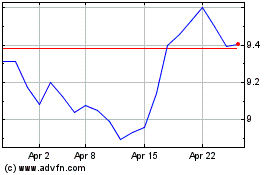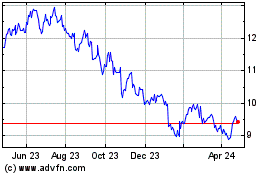By Saabira Chaudhuri
To flavor or not to flavor: That is the question for booze
makers.
Alcohol executives argue that flavored extensions of existing
spirits brands can attract new customers -- particularly women --
while reviving interest among existing drinkers.
But flavors often tend to be fads, meaning sales plummet when
customers tire of the new taste. That piles pressure on alcohol
makers to continually discover the next big thing or brace for wild
revenue swings.
"If you overdo it, you get into dangerous territory. You're a
little bit like a hamster on a wheel who has to run faster and
faster just to stay still," said Bob Kunze-Concewitz, chief
executive of Davide Campari-Milano SpA, which owns brands such as
Campari liqueur and Skyy vodka.
An apple variant of Crown Royal Canadian whisky that Diageo PLC
launched at the end of 2014 helped the brand rebound from stagnant
revenue to a 12% jump in North America sales for fiscal 2015.
Diageo in 2014 also unveiled a range of Canadian whiskies in pie
flavors such as apple, cherry and pecan.
Diageo's Piehole Whiskey, however, hasn't gained traction, and
Crown Royal's North American growth halved in fiscal 2016. Now,
Diageo hopes that its new vanilla Crown Royal flavor, which it
announced last month, will again juice sales.
"It tastes good and a lot of my friends like it because they can
drink it straight," said Justin Capetillo, a 35-year-old
Houston-based cameraman.
Although advertising costs can be hefty, creating the new
flavors isn't particularly expensive. New variants usually are
developed internally and packaging costs generally are minimal,
mainly requiring a modified label. Consumer research typically runs
between $50,000 and $150,000, said Angelo Vassallo, a former
marketing executive for Seagram Co.
Results, however, are choppy. Brown-Forman Corp. in August
reported its cinnamon-flavored extension of Jack Daniel's Tennessee
whiskey declined in the U.S. by a double-digit percentage in the
first quarter of fiscal 2017. The company doesn't plan to create
any new flavors for Jack Daniel's, instead focusing on expanding
the brand outside the U.S.
John McDonnell, a former Seagram executive, recalls how the
company's Leroux cordials brand churned out flavor after
flavor.
"We were releasing a new flavor every month and just doing it to
pipeline product into distributors' warehouses," said Mr.
McDonnell, now the managing director of international operations
for Fifth Generation Inc.'s Tito's Handmade Vodka, which hasn't
released flavored extensions. "It finally just backs up." Leroux is
now owned by Beam Suntory Inc., which sells 27 flavors of the
cordial.
San Diego-based Jeremy LeBlanc, who has been a bartender for 18
years, says the recent trend toward craft cocktails hasn't helped
demand for flavor extensions. "A lot of mixologists doing craft
cocktails stick their noses up at flavored spirits because
everything is about fresh ingredients," the 41-year-old said.
Companies sometimes decide to flavor brands that are
struggling.
Pernod Ricard SA in 2013 rolled out honey- and apple-flavored
variants of its Paddy Irish whiskey, but the new lines weren't able
to stop the declines in market share. In May, it sold Paddy to
Sazerac Co.
By contrast, Pernod hasn't created flavors for its flagship
Irish whiskey Jameson, instead pouring money into more
sophisticated innovations such as Caskmates, a Jameson variant
seasoned in beer casks.
"The Jameson Caskmates initiative has a lot more substance to it
and is much more appealing than just coming up with yet another
flavor," said Pernod CEO Alex Ricard earlier this year.
Sazerac CEO Mark Brown said he is reviewing the flavored
versions of Paddy and won't roll out additional ones. "When you
take a brand down the flavor path, you really are taking an
enormous risk with brand equity," he said. "You don't see serious
brands of whiskey launching flavors."
Mr. Brown remains in favor of stand-alone flavored brands, such
as Sazerac's Fireball, a cinnamon-flavored whiskey that soared to
five million cases in 2015 from 50,000 in 2009, according to
investment research firm Bernstein. But even Fireball's growth has
all but flattened recently.
Nowhere has the volatility been more apparent than in vodka,
which for years has relied heavily on flavored extensions.
Diageo in July said full-year sales of Cîroc plunged 43% from a
year earlier, when customers had embraced a new pineapple variant
of the brand. About 80% of the high-end vodka brand's sales come
from flavor extensions.
"In the U.S., we have got to get more resilient and less
dependent on big flavors every year," said Diageo CEO Ivan
Menezes.
Pernod last year took a EUR652 million (about $693 million)
write-down on its Absolut vodka brand, which kick-started the
modern American wave of vodka flavorings.
Flavored vodka's growth slowed to 2.2% in the 52 weeks ended
Sept. 10 from 12% in the same period in 2013, according to Nielsen
data. The slowdown of flavored vodkas portends the potential risk
for flavored whiskey, whose growth deteriorated to 13% in the 52
weeks ended Sept. 10 from a 132% rise in 2013 and a 71% increase in
2014.
Diageo, however, remains upbeat about its recent launch of Crown
Royal vanilla-flavored whisky. "The life cycle of flavors on whisky
may be longer than the life cycle of flavors on vodka," said James
Thompson, Diageo's chief marketing officer for North America. "Our
research on vanilla gives us confidence."
Write to Saabira Chaudhuri at saabira.chaudhuri@wsj.com
(END) Dow Jones Newswires
November 18, 2016 11:20 ET (16:20 GMT)
Copyright (c) 2016 Dow Jones & Company, Inc.
Davide Campari (BIT:CPR)
Historical Stock Chart
From Apr 2024 to May 2024

Davide Campari (BIT:CPR)
Historical Stock Chart
From May 2023 to May 2024
